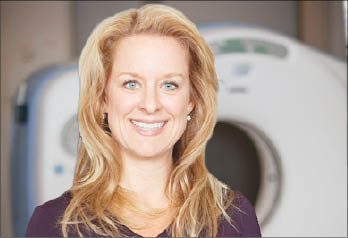
Home » Inland Imaging looks to cut out unnecessary radiation
Inland Imaging looks to cut out unnecessary radiation
New program, education for medical community key to decreasing doses

August 30, 2012
Inland Imaging LLC, of Spokane, plans to start slowly rolling out a methodology to decrease unnecessary radiation use, particularly with computed tomography, or CT, scans.
Through radiologists' efforts, the big imaging services provider in some cases has cut the radiation dose amount by more than half. Pediatric radiologist Dr. Terri Lewis says once the methodology for the dose reduction program is solidified, Inland Imaging plans to apply the program to its own six scanners as well as pass it along to the network of 34 other scanners throughout Washington for which its radiologists read images.
Championed by two Inland Imaging radiologists, the program aims to identify different ways to cut down the radiation dose from scanner to scanner within the network without compromising image integrity. So far through the program, Inland Imaging has seen a 60 percent decrease in CT scan radiation dose, compared with a typical scan, says Angela Steinbach, CT manager.
In addition to the dose reduction program, Inland Imaging offers education opportunities for providers such as nurse practitioners and physicians' assistants in Spokane to learn more about appropriateness of ordering tests and other topics related to radiology.
Inland Imaging estimates it performs about 50,000 CT scans annually through its seven locations in the Spokane area and has about 60 radiologists on staff.
Of the radiation generated to produce a CT scan image, Steinbach says, "It's the same principle as when you're taking an X-ray. It uses radiation physics to produce the image."
Radiation may increase the chance of a patient developing cancer later in life, she says, but that is a small risk compared with the potential life-saving benefits of a CT scan if it reveals something that needs to be treated right away.
Steinbach says the dose reduction program has been in the works for several months.
"Companies (that make CT scanners) are working on lowering radiation dose also; this is something that's out there, and as they improve their scanners, it does lower the dose," Steinbach says. "The radiologists are trying to take it a step further and lower it more."
The key is to make sure the dose of radiation isn't cut so much that the scans are no longer readable.
"There's a direct correlation between radiation and quality of image," Steinbach says.
Lewis says the process to reduce radiation risk beyond the program happens in two parts. The first step starts with educating the referring nurse practitioners or physicians' assistants who order tests.
The second step in the process involves Inland Imaging technologists acting as screeners when patients come in for tests. Lewis says it has access to many previous studies, and sometimes a technologist will notice a similar scan had already been completed elsewhere.
"We try to screen patients along the road to make sure they haven't had a scan recently," Lewis says. "If they don't order the CT scan, then the radiation risk is zero."
She says if a test needs to be repeated or a new test is ordered, new technology and machines are in place at Inland Imaging to lower unnecessary radiation.
"Our scanners are preprogrammed to minimize radiation dose based on patient size, the body part being scanned, and type of study," Lewis says. A technologist could scan the chest for several different reasons, she says, and each scan is conducted differently depending on what is being examined. The clinical reason for the study dictates to the technologist which protocol to use and which set of parameters is appropriate.
Inland Imaging has been part of a national campaign known as Image Gently. First started in 2008, the Image Gently campaign looks to increase awareness of opportunities to protect children against radiation during imaging.
When conducting a test, she says providers and technologists need to weigh the risk of radiation or more specifically, the potential risk of damage to genetic material within cells. For children, Lewis says there's more room to grow, so damage is looked at more closely. She says in some cases, despite the risks involved, a scan is necessary.
"The risk of what's going on in their body is greater than the risk of doing the scan," Lewis says.
For example, the only ways to see a tumor in a patient who has cancer are through an invasive surgical procedure or through imaging. In such a case, the benefits of a CT scan outweigh the risks.
Latest News
Related Articles



